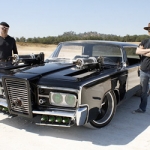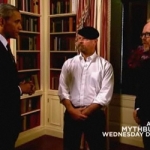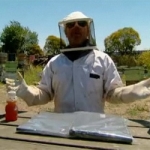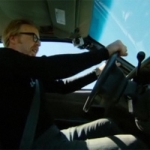
Episode: Mythbusters 8.21 – “Tablecloth Chaos”
Original Air Date: October 27, 2010
You’ve probably seen the “magic trick” where someone pulls the tablecloth off of a table, leaving the things on it undisturbed. You’ve probably also been told at some point in your life that humans only use 10% of their brains. If you’ve seen or heard either and ever wondered if they were true, then Wednesday was your lucky day, because that’s what the Mythbusters tackled on their most recent episode.
But, you might say, the tablecloth scenario is not a myth, it’s a demonstration of Newton’s First Law of Motion: An object at rest stays at rest unless acted on by an outside force. True, but in a viral video on the internet where a motorcycle pulls a table cloth out from under twenty-four place settings as well as a number of candelabras, wine buckets, and flower arrangements without disturbing a single fork, are the laws of physics really at work, or is there some trickery going on? Never fear, the Mythbusters are on the case! (As usual, results will be divulged, so consider yourself warned if you don’t want to be spoiled.)
Myth 1: You can pull a tablecloth out from under a table fully set for 24 people using the speed and power of a motorcycle with the same result as a person pulling a tablecloth off of a small table set with a few things, i.e., everything in the same place, nothing moved or knocked over.
Mythbusters: Adam and Jamie
Step 1: Small Scale Testing
Before tackling the banquet table from the video, Adam was able to eliminate a number of variables in the shop with a small table. He discovered the optimal conditions for most of the elements involved, including the state of the tabletop (smooth — rough plywood doesn’t work), placement of the cloth on the table (with the edge of the cloth at the edge of the table, not hanging over the side), the type of cloth that moves with the least friction (a thin, lightweight satin), and the weight of the objects on the table (the lighter the object, the less friction between it and the cloth). Through the testing process, Adam presumably discovered the best technique and speed for tablecloth pulling as well, although it’s not very relevant to the large scale test.
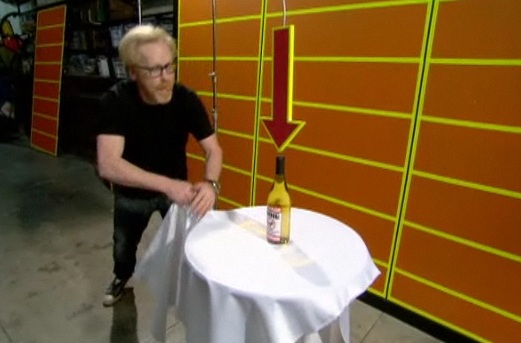
Step 2: Large Scale Re-creation of the Video
Adam and Jamie took the show on the road to a large empty building, where Adam constructed a table big enough to hold twenty-four place settings, consisting of a dinner plate, bread plate, three glasses, and the requisite silverware. In addition to the dishes, the table also held silver candelabras, vases of flowers, and ice buckets holding bottles of wine. One end of the tablecloth was fitted with a bar and rope with which to attach it to the motorcycle, in this case Jamie’s personal souped-up sport bike. At Adam’s signal, Jamie took off, taking the tablecloth with him.
Result: When Jamie rode away with the tablecloth, he took most of the contents of the table with him. Only a few place settings at the far end of the table — the ones that had the least amount of tablecloth to pass under them — remained relatively close to their starting positions. Just about everything else ended up on the floor, in a spectacular trail of destruction as long as, if not longer than, the table itself.
Conclusion: Myth BUSTED — the scenario presented in the video is not possible without some sort of special effects.
Step 3: When the myth is busted, find out what it takes to make it true.
Procedure 1: Part of the problem with the video’s set-up is the fact that the motorcycle starts from zero and accelerates as it pulls the tablecloth instead of pulling at the constant high speed needed to overcome the force of friction. Adam and Jamie decided to try attaching the tablecloth to the motorcycle with a rope that was 200 feet long, allowing the motorcycle time to get up to speed (around 50-60 mph) before beginning to pull the cloth. Additionally, Adam lightened the weight on the table a bit, mainly by pouring out the wine in the wine buckets.
Result: This time, the larger things like flower arrangements and candelabras all fell over and along the sides of the table there was some glass breakage, but overall, only a few place settings went crashing to the floor, compared to only a few that stayed on the table the first time.
Conclusion: There was a definite improvement — maybe a higher speed would produce an even better result.
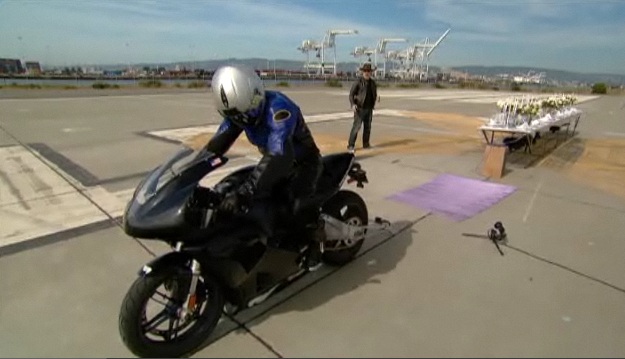
Procedure 2: They moved the whole setup outside to the abandoned runway so that Jamie would have plenty of room to get up to speed — 100 mph in this case. They attached the tablecloth to the bike with 600 feet of rope, and set it with the least weight possible, substituting plastic plates and lighter containers for the heavier tableware used previously.
Result: Despite fairly windy conditions and a do-over due to a ripped cloth, this test was even more successful than the previous, with many of the table decorations staying standing and most of the items remaining on the table. There was a bit of shifting, though, and some of the place settings on the end of the table did fall onto the ground.
Conclusion: They couldn’t make it work, even going far above and beyond the original parameters. The next step would therefore be to try to figure out how exactly they cheated.
Procedure 3: Back inside the original building, Adam and his helpers reset the table, with a few changes. He prepped the table with a substance used to lubricate sailboat sails, and he covered the tablecloth with a sheet of thin, flexible plastic that was bolted down on the opposite end of the table from the motorcycle’s starting position. Jamie took off with no slack in the rope and pulled the tablecloth off of the table.
Result: Since the tablecloth was being pulled between the table and the plastic sheet, no friction was acting on the tableware itself. Therefore, the contents of the table remained in place as the tablecloth was pulled away.
Final Conclusion: This must be what the video-makers did to create the illusion that the tablecloth was being pulled out from under the dishes. There is no possible way to achieve the result of the video otherwise.
Myth #2: Humans only use 10% of their brains.
Mythbusters: Kari, Grant, Tory
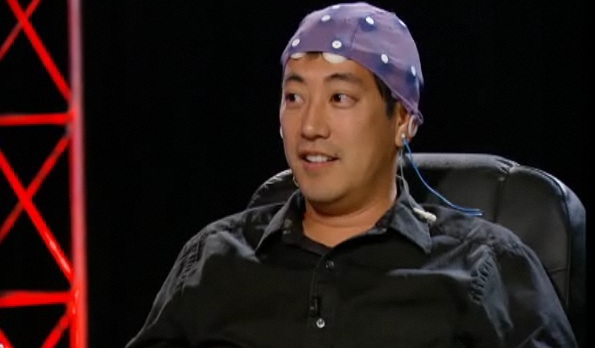
Procedure 1: EEG
After finding out about the different parts of the brain and what each of the four lobes does, the team devised four tests, each of which targeted a specific area of the brain. Grant got to be the guinea pig for this first round. An electroencephalogram (EEG) was administered while Grant answered questions and performed various tasks.
Results: The EEG showed that Grant’s brain was active in the right areas during each test. In other words, the lobe of the brain that was targeted by the tasks or questions was the lobe of the brain that showed the most activity during that segment of the test. However, since the EEG only measures electrical activity at the brain’s surface, there is no way to calculate what percentage of Grant’s brain was actually being used.
Procedure 2: MEG
Tory got to be the next lab rat as the team attempted to go deeper into the brain through a magnetoencephalogram (MEG). The technicians put him through his paces with a series of tests designed, once again, to employ primarily one lobe of the brain at a time.
Results: When the MEG data was broken down by test, Tory was found to be using from 13% to 21% of the lobe being targeted by that particular test. Although one-tenth of a second “snapshots” of brain use showed about 10% being used at any particular point in time, overall Tory was using about 35% of his brain.
Procedure 3: F-MRI
For one final in-depth look at brain activity, Tory underwent a Functional Magnetic Resonance Image (F-MRI) of his brain, first while at rest and then while telling aloud a story about a traumatic event. While describing his ill-fated attempt at jumping over a wagon on a bicycle during a past episode of Mythbusters, many different parts of Tory’s brain were engaged simultaneously.
Results: The F-MRI showed that Tory was using 15% of his brain while at rest and 30% while telling the story.
Conclusion: Both the MEG and the F-MRI showed that Tory was using more than 10% of his brain even when a minimum of activity was going on or only one area was being measured. Myth BUSTED.
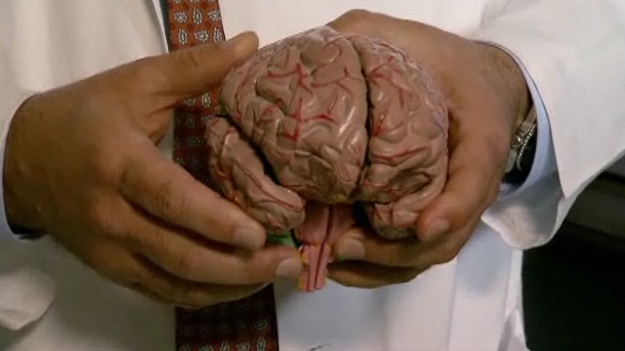
As usual, the Mythbusters have given us a solid episode, although there was nothing tying the two teams’ myths together. I tend to prefer episodes where Adam and Jamie are testing a myth that is somehow related to the myth that Kari, Grant, and Tory are working on, either through common subject matter (as in the sniffer dog myths episode) or myth source (as in the previous episode where each team addressed a well-known saying). Still, we got to see fast vehicles, spectacular breakage and destruction, and uncomfortable situations endured by Grant and Tory. All that and science too — what more could you ask for? Well, if you do want to see more camera angles and more high-speed camera footage, or have more behind-the-scenes questions answered, be sure to check out the bonus video content online at Discovery.com.
Rating: 4 / 5 Stars



